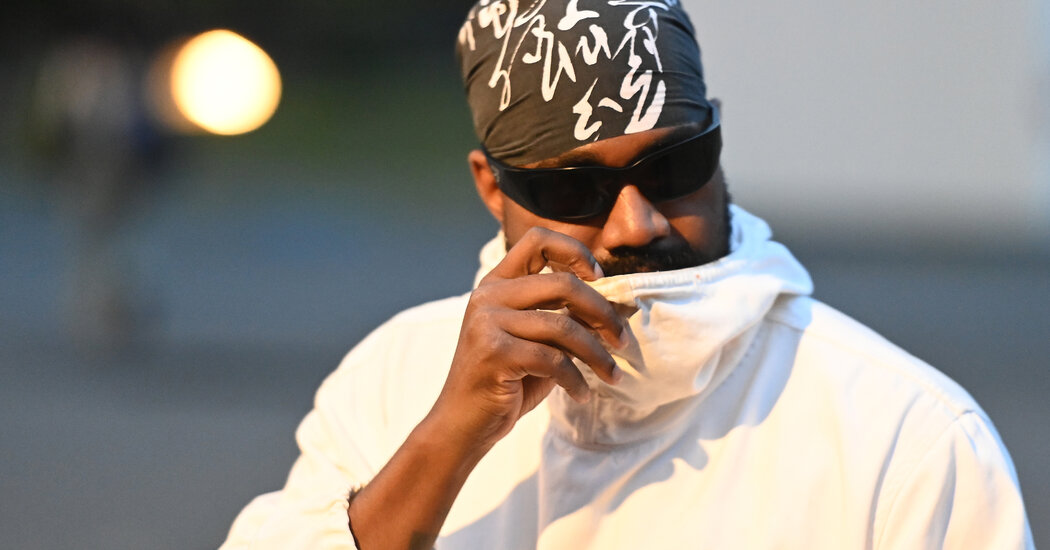When Ye speaks, his fans listen. Even if they have no idea what he’s saying.
This was on display in recent weeks when the artist formerly known as Kanye West released a new crop of clothing through his Yzy Supply online store, including a number of pared-back pieces with Cyrillic and Greek lettering on them. The grim website gave no clues about the messages on the clothing. Kanyeologists were stunned.
“Would be nice to know what it actually says,” read one comment on the Yeezy Subreddit.
“What do these mean,” another user wondered.
Of course, it’s wise to understand what a shirt says before you buy it. A Mets fan would never want to buy a jersey that says “Yankees” in Russian. But that vigilance is all the more understandable when it comes to Ye, whose wave of anti-Semitic and offensive comments in 2022 resulted in his reputation self-immolation. Adidas, which had a long-term and lucrative partnership with Ye, cut ties with the musician. The Creative Artists Agency dropped him as a client.
Some of Ye’s strident fans continue to exhibit a sense of confusion, if not trepidation, about the messages on his clothing — especially those conveyed through his revived Yeezy label. Kanye and Yeezy’s subreddits are rich with discussions from users debating the true meaning behind the images and non-English sentences.
An earlier series of clothing printed with ‘Black Dogs’ in Russian prompted one Redditor to investigate if anyone knew the meaning of the phrase.
“I want to order one, but for obvious reasons I want to know where the phrase comes from,” the Redditor wrote. The resulting answers were scattered and perhaps not serious: it was a Russian propaganda dog whistle, a Led Zeppelin reference, an omen of death.
The latest batch of Yeezy clothing features even more confusing slogans. Hoodies, sweatshirts, shorts and jackets feature Russian words that roughly translate to ‘Herald Tribune’. Whether this is a reference to the bygone international newspaper or just a nod to the vox populi is not clear. Experts say that the short phrase in Russian has no hidden meaning.
“It doesn’t evoke any obvious Russian references,” Tatyana Gershkovich, an associate professor of Russian studies at Carnegie Mellon University, wrote in an email. “From my bit of Googling, it appears that the two words together are only on Kanye’s clothing.”
Similarly, Eliot Borenstein, professor of Russian and Slavic studies at New York University, felt that the phrase would not ring a bell among Russian readers.
“If you speak Russian and have never heard of the newspaper, this sentence would make no sense,” he wrote via email. “It’s not hyphenated, so it looks like two random nouns jumbled together.”
An email to a contact on the Yeezy website went unanswered.
Another series of clothes featured a trio of Greek-looking letters, which were “just shy of gibberish,” said Marcus Folch, an associate professor of classics at Columbia University.
As he noted via email, the letters appeared to form a graphic play on YZY. “It looks cool,” Mr. Folch said. “But it has nothing to do with Greek.” The N’s, he noted, are printed backwards.
In a sense, Yeezy’s linguistic plays are a fading echo of a modest trend from a few years ago, when streetwear-tinged brands printed Cyrillic words on their clothes. The actual lyrics were never as meaningful as when American designer Heron Preston sold shirts with the word “style” in Russian. This was not Chekhov.
Yet there was something graphically appealing about Cyrillic, a blocky alphabet that was inscrutable to American shoppers. It became a tool for designers looking to sprinkle some international intrigue on otherwise basic hoodies and T-shirts.
The trendy use of Russian script disappeared as Russia reasserted its military power and all but ceased by the start of the 2022 invasion of Ukraine.
If Yeezy pushes back on this trend, the impetus will undoubtedly come from the label’s head of design, Russian designer Gosha Rubchinskiy. In December 2023, when Ye rejoined X and appointed Mr. Rubchinskiy, the announcement raised eyebrows in the fashion world.
For years, Rubchinskiy’s collections – a mash-up of old-school sportswear, cobbled-together militaria and surprisingly grown-up tailoring – were raved about by critics and retailers. He was hailed as a generational talent when he collaborated with Adidas, Burberry, Levi’s and Dr. Martens. Some of Mr. Rubchinskiy’s garments featured Cyrillic phrases and logo marks, a design detail he apparently carried over to Yeezy.
And then, in 2018, a 16-year-old model accused Mr Rubchinskiy of asking him for indecent images. He denied the accusations and continued designing, but the industry cooled him down. In Mr. Rubchinskiy, Ye found a kindred exile from the catwalk fashion system.
Although the Yeezy line continues to share a name with the line Ye operated with Adidas (albeit now often stylized to eliminate the e’s), today’s Yeezy brand is a radical retail experiment that departs from all of Ye’s previous apparel projects.
Today, there are no Yeezy fashion shows and no retail partnerships with Gap. Once known for his sensual color experiments (people may downplay it now, but Ye’s earth-tone revolution changed fashion for a few years), Ye has retreated into a spartan palate. His clothing is available in three colors: white, gray and black.
Each item, including a windbreaker shaped like a painter’s smock, shorts with an elastic waist and the slippers he introduced this week, sells for $20. Although Ye once competed for attention on the runway, his designs now have more in common with surplus army supplies or even prison uniforms than with the fantastic creations coming out of Paris Fashion Week.
Still, Ye’s venture appears to be working – at least according to him. On Tuesday morning, Ye posted on Instagram that the store had achieved more than $2.3 million in sales on Monday.





